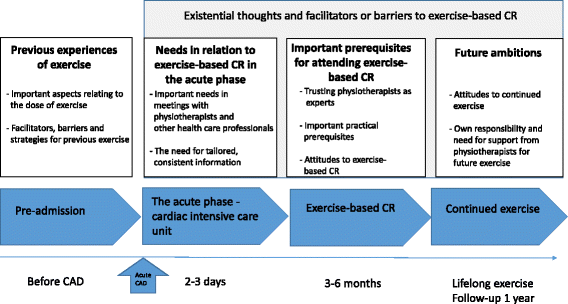Important aspects in relation to patients' attendance at exercise-based cardiac rehabilitation - facilitators, barriers and physiotherapist's role: a qualitative study
- PMID: 28288580
- PMCID: PMC5348799
- DOI: 10.1186/s12872-017-0512-7
Important aspects in relation to patients' attendance at exercise-based cardiac rehabilitation - facilitators, barriers and physiotherapist's role: a qualitative study
Abstract
Background: In order to improve attendance at exercise-based cardiac rehabilitation (CR), a greater insight into patients' perspectives is necessary. The aim of the study was to explore aspects that influence patients' attendance at exercise-based CR after acute coronary artery disease (CAD) and the role of the physiotherapist in patients' attendance at exercise-based CR.
Methods: A total of 16 informants, (5 women; median age 64.5, range 47-79 years), diagnosed with CAD, were included in the study at the Cardiology Department, Linköping University Hospital, Sweden. Qualitative interviews were conducted and analysed according to inductive content analysis.
Results: Four main categories were identified: (i) previous experience of exercise, (ii) needs in the acute phase, (iii) important prerequisites for attending exercise-based CR and (iv) future ambitions. The categories demonstrate that there are connections between the past, the present and the future, in terms of attitudes to facilitators, barriers and the use of strategies for managing exercise. An overall theme, defined as existential thoughts, had a major impact on the patients' attitudes to attending exercise-based CR. The interaction and meetings with the physiotherapists in the acute phase were described as important factors for attending exercise-based CR. Moreover, informants could feel that the physiotherapists supported them in learning the right level of effort during exercise and reducing the fear of exercise.
Conclusions: This study adds to previous knowledge of barriers and facilitators for exercise-based CR that patients with CAD get existential thoughts both related to exercise during the rehabilitation process and for future attitudes to exercise. This knowledge might necessitate greater attention to the physiotherapist-patient interaction. To be able to tailor exercise-based CR for patients, physiotherapists need to be aware of patients' past experiences of exercise and previous phases of the rehabilitation process as these are important for how patients' perceive their need and ability of exercise.
Keywords: Content analysis; Coronary artery disease; Exercise; Interviews; Patient perspective.
Figures
References
-
- World Health Organisation. Global health observatory data repository. In.http://apps.who.int/gho/data/?theme=main (Accessed 22 Jan 2017).
-
- Balady GJ, Williams MA, Ades PA, Bittner V, Comoss P, Foody JM, Franklin B, Sanderson B, Southard D, American Heart Association Exercise CR et al. Core components of cardiac rehabilitation/secondary prevention programs: 2007 update: a scientific statement from the American Heart Association Exercise, Cardiac Rehabilitation, and Prevention Committee, the Council on Clinical Cardiology; the Councils on Cardiovascular Nursing, Epidemiology and Prevention, and Nutrition, Physical Activity, and Metabolism; and the American Association of Cardiovascular and Pulmonary Rehabilitation. Circulation. 2007;115(20):2675–2682. doi: 10.1161/CIRCULATIONAHA.106.180945. - DOI - PubMed
-
- WHO: Secondary prevention in primary and secondary care following myocardial infarction. Clinical Guidelines CG 172. . In. London: NICE; 2013.
-
- European Association of Cardiovascular P. Rehabilitation Committee for Science G. Eacpr, Corra U, Piepoli MF, Carre F, Heuschmann P, Hoffmann U, Verschuren M, Halcox J, et al. Secondary prevention through cardiac rehabilitation: physical activity counselling and exercise training: key components of the position paper from the Cardiac Rehabilitation Section of the European Association of Cardiovascular Prevention and Rehabilitation. Eur Heart J. 2010;31(16):1967–1974. doi: 10.1093/eurheartj/ehq236. - DOI - PubMed
MeSH terms
LinkOut - more resources
Full Text Sources
Other Literature Sources
Medical
Miscellaneous


